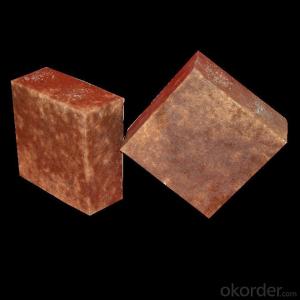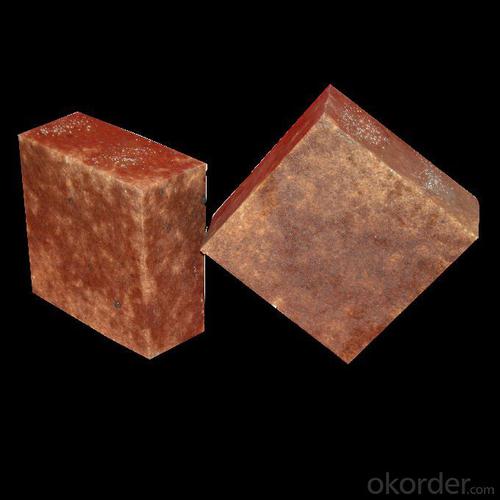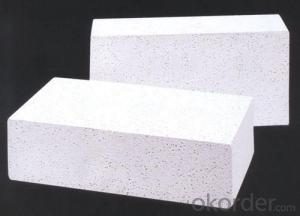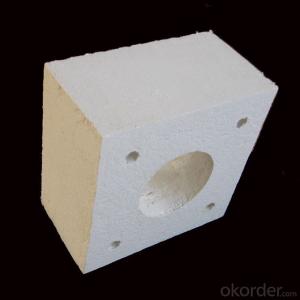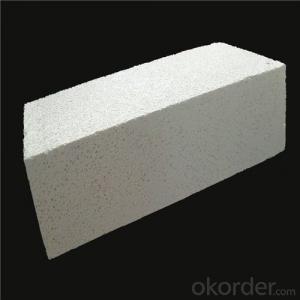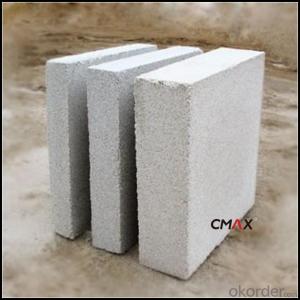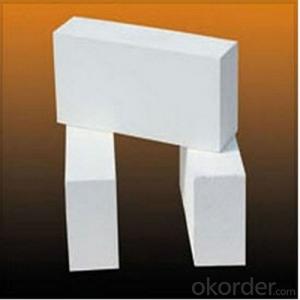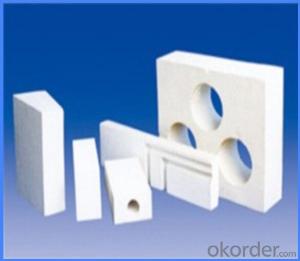Insulating Fire Brick for Ladle High Temperature Refractory Brick
- Loading Port:
- Shanghai
- Payment Terms:
- TT OR LC
- Min Order Qty:
- 10 m.t.
- Supply Capability:
- 100 m.t./month
OKorder Service Pledge
OKorder Financial Service
You Might Also Like
Quick Details
| Place of Origin: | (Mainland) | Shape: | Brick | Material: | Alumina Block |
| SiO2 Content (%): | 60-20% | Al2O3 Content (%): | 40-80% | MgO Content (%): | 0 |
| CaO Content (%): | 0 | Refractoriness (Degree): | 1770°< Refractoriness< 2000° | CrO Content (%): | 0 |
| SiC Content (%): | 0 | Model Number: | 69022000 | Brand Name: |
Packaging & Delivery
| Packaging Detail: | wooden pallet |
| Delivery Detail: | 30days |
Specifications
Refractory bricks for ladle, hot blast furnace
High alumina bricks
Fireclay bricks
Insulating bricks
Runner bricks
Our company located in yangquan city,Shanxi province, China, and Yanquan city is one of the
largest refractory material base in China. We are in position to supply various kinds of
refractory bricks, such as high alumina and fireclay bricks, insulating bricks etc
with the catalogue as follows:
1. fireclay brick
2. high alumina brick
3. insulating brick
4. unsintered phosphate brick
5. Al-C sliding plate
6. nozzle
7. hollowwares
8. refractory Mortar
9. refractory castables
10.other refractory material
If interested, pls do feel free to contact me.
Production can be arranged according to your specific requirements & drawings.
Looking forward to hearing from you the soonest.
FIRECLAY BRICK FOR GENERAL USE
Y-FB GFB40 GFB42 GFB45 |
Al2O3(%)min. 40 40 42 45 |
Fe2O3(%)max. 2.5 |
Refractoriness()min. 1710 1730 1750 1750 |
Refractoriness under load 0.2MPa()min. 1300 1350 1400 1400 |
Apparent porosity(%)max. 22 20 20 20 |
Cold crushing strength (MPa)min. 30 30 35 40 |
Linear change after reheating(%)max. At 1350×2h +0.1 -0.4 At 1400×3h +0.1 +0.1 +0.2 -0.5 -0.4 -0.2 |
Refractory Bricks
item | SK-32 | SK-34 | SK-36 | SK-37 | SK-38 |
Al2O3(%) | 38 | 42 | 50 | 65 | 70 |
Fe2O3 (%) | 3 | 2.5 | 2.5 | 2.4 | 2 |
Refractoriness (SK) | 32 (1710°C) | 34 (1750°C) | 36 (1790°C) | 37 (1825°C) | 38 (1850°C) |
Refractoriness under load, 0.2MPa, Ta, (°C) | 1300 | 1350 | 1450 | 1550 | 1580 |
Porosity (%) | 26 | 25 | 24 | 23 | 23 |
Bulk density (g/cm³) | 2.05 | 2.1-2.15 | 2.3-2.4 | 2.4 | 2.5 |
Cold crushing strength (MPa) | 25 | 25 | 45 | 45 | 51 |
- Q: Can insulating fire bricks be used in solar power plants?
- Yes, insulating fire bricks can be used in solar power plants. Insulating fire bricks are designed to have excellent thermal insulation properties, making them suitable for applications that require heat resistance and energy efficiency. Solar power plants often involve high temperatures and the need to retain heat, such as in concentrated solar power (CSP) systems. Insulating fire bricks can be used to line the walls and floors of CSP receivers and thermal storage systems, helping to minimize heat loss and maximize the conversion of solar energy into electricity. Additionally, insulating fire bricks can also be used in other components of solar power plants, such as in the insulation of solar panels or in the construction of solar tower structures.
- Q: Can insulating fire bricks be used in the insulation of walls and roofs?
- Insulating fire bricks excel in withstanding extreme heat and are primarily intended for high-temperature applications like kilns, furnaces, and fireplaces. However, they may not be the optimal choice for insulating walls and roofs. Although insulating fire bricks possess a high thermal resistance that effectively minimizes heat transfer, they fall short in terms of preventing air infiltration and delivering superior insulation compared to materials specifically designed for building insulation. When it comes to insulating walls and roofs, it is more customary to employ materials such as fiberglass, mineral wool, foam boards, or spray foam insulation. These materials boast superior insulating properties and are specifically engineered to offer thermal resistance, air sealing, and moisture control. If you are contemplating the use of insulating fire bricks for wall or roof insulation, it is crucial to seek advice from a professional who can assess your specific requirements and recommend the most suitable materials for your project.
- Q: Are insulating fire bricks resistant to spalling?
- Yes, insulating fire bricks are resistant to spalling.
- Q: What are the advantages of using insulating fire bricks over other insulation materials?
- There are several advantages to using insulating fire bricks over other insulation materials. Firstly, insulating fire bricks have a high thermal conductivity, meaning they can effectively insulate against heat transfer. This makes them ideal for applications where heat containment is crucial, such as in furnaces, kilns, and industrial ovens. Their ability to withstand high temperatures and prevent heat loss makes them a reliable choice for insulation. Secondly, insulating fire bricks are highly durable and resistant to wear and tear. They are made from high-quality refractory materials, which are designed to withstand extreme conditions, including thermal shocks and chemical exposure. This durability ensures a longer lifespan and reduces the need for frequent replacements or repairs. Another advantage is their versatility. Insulating fire bricks come in various shapes and sizes, allowing for easy customization and installation in different applications. They can be easily cut or shaped to fit specific requirements, making them suitable for complex geometries or curved surfaces. This flexibility allows for efficient insulation in a wide range of settings. Moreover, insulating fire bricks have excellent insulation properties even at lower densities. This means that they can provide optimal thermal insulation while also reducing the overall weight of the structure. This is particularly advantageous in industries where weight reduction is critical, such as aerospace or automotive manufacturing. Lastly, insulating fire bricks are environmentally friendly. They are typically made from natural and recyclable materials, minimizing their impact on the environment. Additionally, their long lifespan and low maintenance requirements contribute to sustainability by reducing waste generation and energy consumption. In conclusion, the advantages of using insulating fire bricks over other insulation materials include high thermal conductivity, durability, versatility, lightweight, and environmental friendliness. These characteristics make them a preferred choice for insulation in various industries and applications.
- Q: Are insulating fire bricks suitable for use in the construction of incinerators?
- Insulating fire bricks prove to be a suitable option for constructing incinerators. They are specifically designed to endure high temperatures and possess exceptional insulation properties. Incinerators operate at extremely high temperatures, often surpassing 1000 degrees Celsius, and require materials that can withstand such intense conditions without cracking or deteriorating. Made from lightweight refractory materials like ceramic fibers or lightweight aggregates, insulating fire bricks possess low thermal conductivity. Consequently, they effectively insulate the incinerator, preventing heat escape and maximizing energy efficiency. Moreover, the insulation properties of these bricks aid in maintaining a consistent temperature inside the incinerator, which is crucial for proper combustion and waste disposal. Furthermore, insulating fire bricks exhibit remarkable resistance to thermal shock, enabling them to withstand repeated cycles of heating and cooling without sustaining damage. This attribute is particularly vital in incinerators, where the temperature can rapidly fluctuate during the burning process. The bricks' capacity to endure thermal shock guarantees their durability and longevity in this high-temperature environment. Apart from their insulation and thermal shock resistance, insulating fire bricks offer additional advantages for incinerator construction. They possess a lightweight nature, facilitating easier handling and transportation during the construction phase. Furthermore, they can be readily cut or shaped to fit specific designs or requirements, allowing for flexibility in incinerator construction. In conclusion, insulating fire bricks stand as an ideal choice for incinerator construction due to their resistance to high temperatures, insulation properties, thermal shock resistance, durability, and ease of use. They provide a reliable and efficient solution for containing and maintaining the intense heat generated in incinerators, ensuring the safe and effective disposal of waste.
- Q: Do insulating fire bricks have a low thermal expansion rate?
- Insulating fire bricks are known for their low thermal expansion rate. They are specifically designed to endure high temperatures and thermal shocks, with one of their key features being their ability to retain their shape and dimensions even in extreme heat conditions. These bricks are produced from materials that possess a low coefficient of thermal expansion, which means they undergo minimal expansion and contraction when exposed to temperature changes. This characteristic guarantees the stability of the bricks, preventing them from cracking or breaking due to thermal stress. Moreover, the low thermal expansion rate of insulating fire bricks contributes to improved insulation performance. By minimizing the formation of gaps between the bricks during expansion and contraction, heat loss is reduced and energy efficiency is enhanced.
- Q: Can insulating fire bricks be used for insulation in petrochemical plants?
- Insulating fire bricks have multiple applications, one of which is their use in petrochemical plants for insulation purposes. These bricks possess exceptional thermal properties, characterized by their low thermal conductivity and high resistance to heat transfer. These remarkable features render them suitable for deployment in high-temperature environments, such as petrochemical plants. In such settings, insulation plays a critical role in preventing heat loss and maintaining optimal operational conditions. Moreover, these bricks are not only lightweight but also possess robust mechanical strength. This facilitates their easy installation and ensures durability in industrial settings. Additionally, their resistance to chemical corrosion is a crucial attribute for petrochemical plants that handle a wide range of corrosive substances. Consequently, insulating fire bricks effectively fulfill the insulation requirements, thereby enhancing energy efficiency and promoting safety in petrochemical plants.
- Q: Do insulating fire bricks require special handling?
- Yes, insulating fire bricks do require special handling. They are fragile and can easily break, so they should be handled with care to prevent any damage. It is also important to protect them from moisture as it can affect their insulating properties. Additionally, proper safety measures should be taken when working with insulating fire bricks, such as wearing protective gloves and eyewear to avoid any potential injuries.
- Q: Are insulating fire bricks suitable for use in steel mills?
- Yes, insulating fire bricks are suitable for use in steel mills. Insulating fire bricks are made from lightweight materials that have high insulating properties, allowing them to withstand high temperatures and provide effective insulation. In steel mills, where extremely high temperatures are generated during the steelmaking process, insulating fire bricks are used to line furnaces, kilns, and other high-temperature applications. These bricks help to reduce heat loss, improve energy efficiency, and protect the steel mill equipment from excessive heat. Additionally, insulating fire bricks have good thermal shock resistance, which is essential in steel mills where rapid temperature changes occur. Overall, the use of insulating fire bricks in steel mills is a reliable and effective solution for maintaining high-temperature environments and optimizing the steelmaking process.
- Q: Can insulating fire bricks be used for fireplace lining?
- Indeed, fireplace lining can be achieved using insulating fire bricks. These bricks are specially engineered to endure high temperatures and offer exceptional insulation. With their low thermal conductivity, they excel at retaining heat and preventing excessive heat loss from the fireplace. Consequently, they are an ideal choice for lining fireplaces as they augment the efficiency and efficacy of the heating system. Moreover, insulating fire bricks exhibit resistance to thermal shock and can withstand rapid temperature fluctuations, a crucial attribute in fireplaces where temperatures can vary significantly. All in all, incorporating insulating fire bricks for fireplace lining can enhance the performance and energy efficiency of the fireplace while ensuring its safety and durability.
Send your message to us
Insulating Fire Brick for Ladle High Temperature Refractory Brick
- Loading Port:
- Shanghai
- Payment Terms:
- TT OR LC
- Min Order Qty:
- 10 m.t.
- Supply Capability:
- 100 m.t./month
OKorder Service Pledge
OKorder Financial Service
Similar products
Hot products
Hot Searches
Related keywords
